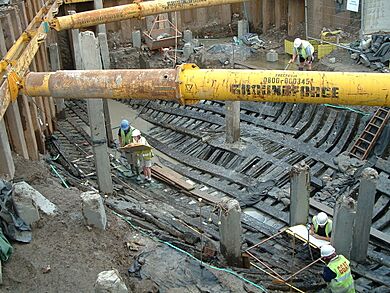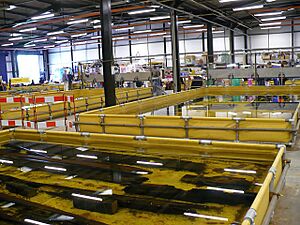Newport Ship facts for kids

The Newport Ship is an old sailing ship from the mid-1400s. It was found by archaeologists in June 2002 in Newport, South East Wales. The ship was discovered on the west bank of the River Usk while a new building, the Riverfront Arts Centre, was being built. Its official name is now the Newport Medieval Ship.
This ship was very large for its time, about 116 feet (35 metres) long. It could carry about 161 tons of cargo. This means it could hold 161 large barrels of wine! Ships this size were called 'great ships'. They were used for long trips between Britain, Biscay (a bay in Spain and France), and southern Spain and Portugal.
The ship was likely built right after the winter of 1457/8. Scientists figured this out by studying the wood. Most of the wood came from the Basque region of northern Spain. This area was famous for building ships back then. Later repairs used wood from Britain. The ship was being fixed when it got stuck and was left behind.
At first, there were no plans to save the whole ship. But local people really wanted to save it. They started a group called the Friends of the Newport Ship. Saving the ship was very expensive, costing about £3.5 million. The Welsh Assembly Government and Newport City Council helped pay for it. All of the ship's wooden pieces have been carefully taken out. They are now in a special building. This place is the biggest wood conservation centre in the UK. Here, experts are working to preserve the wood and learn more about the ship.
Contents
How the Ship Was Lost
The River Usk has very high and low tides. It seems the ship was floated into a side channel during a very high tide. It was placed on a special support made of oak and elm logs. The ship was getting a big repair, as new British wood was being added.
But before the repairs were finished, the support structure broke. The ship tipped over onto its right side. When the tide came in, the ship filled with mud and water. People tried to pump out the water and fix the ship, but they couldn't. So, they started taking out useful parts. They removed wood and iron to use again. They also took out big items like anchors and ropes. To do this, they cut parts of the ship with axes. Many loose pieces of wood were left inside the ship.
Ship's Size and Build
The ship's wood is in excellent condition. This is probably because the mud in the River Usk has very little oxygen. This stopped tiny creatures from eating the wood. Part of the ship's left side was cut down. But luckily, this helped keep the correct shape of the hull. The right side, which fell into the mud, is almost fully preserved.
The ship is about 116 feet (35 metres) long and 27 feet (8.2 metres) wide. It could carry 161 'tons burden' of cargo. This was how people measured ship size back then. In the 1460s, ships over 150 tons were called 'great ships'. They were mainly used for long trips to southern Europe, like Lisbon in Portugal.
The ship was built using a method called clinker built. This means each plank of wood overlaps the one below it. The outer planks were put on first. They were held together with iron nails. The nails were hammered flat to make a tight seal. Gaps were filled with caulking (a sealing material) made of tar and animal hair. Hair from horses, cows, sheep, and goats was found.
The ship's frames (like ribs) were then put inside the hull. They were attached to the planks. The main spine of the ship is called the keel. It is made of beech wood. The rest of the ship is made of oak. We don't know why two different woods were used. Maybe there wasn't enough oak when it was built. The planks were shaped with an axe or adze.
Inside the frames, there were long pieces of wood called stringers. These helped make the ship strong. The inside of the hull was also lined with thinner planks. These 'ceiling planks' stopped cargo from touching the outer hull. Both the stringers and ceiling planks were made of sawn oak.
When the wood was cleaned, workers found special marks on the outer planks. These marks might be from the shipbuilders. Or they could be instructions for placing the planks. In 2007, marks were found on barrel pieces. Some look like marks used by merchants from Bristol. But this doesn't prove where they came from.
How Old Is the Ship?
The first studies of the wood showed that most of it came from the Basque Country in northern Spain. This wood was cut around 1449. Later studies showed that the trees used for the original ship were cut in the winter of 1457/8. Since ships were often built with fresh wood back then, the ship was likely built soon after this date.
In 2006, a French silver coin was found in the ship. It was placed in a cut-out part of the ship's front. This coin was made between May and July 1447. It might have been placed there for good luck when building started. Logs found under the ship, which supported it during repairs, date to spring 1468. This means the ship was used for less than 10 years.
Some people think the ship might have belonged to the Earl of Warwick by 1469. A letter from him mentioned payments for "the making of the ship at Newport." This could mean repairs to this damaged ship. But it's hard to be sure. It's more likely that this was a ship from Spain or Portugal that needed repairs near Bristol. Newport sometimes had very large ships like this one. They helped with the long-distance trade of Bristol, which was a very important port.
What Was Found Inside
During the dig, hundreds of objects were found inside the ship. These included a stone cannonball, grape seeds, a broken hour glass, and 13 single shoes. One shoe was very expensive! Pieces of cork and some Portuguese coins were also found. The seeds, cork, and coins suggest the ship traded with the Iberian peninsula (Spain and Portugal). Finding Merino sheep wool in the sealing material also supports this idea.
Experts from the Albaola Society in Spain believe the ship was built by Basque shipbuilders. This could have been in Spain or France. The items found, like Portuguese coins and pottery, show strong trade links with Portugal. It's also very possible that the ship had a Portuguese crew. Most of the pottery pieces were red-ware from Spain or Portugal. They were different shapes and some had soot on them. This suggests they were used by the crew, not as cargo.
Scientists also found many well-preserved plant, insect, and animal remains. Food items included walnuts, almonds, hazelnuts, pomegranates, grapes, figs, and olives. Over a thousand fish and animal bones were found. Fish included cod, hake, ling, and salmon. Shellfish like oysters and mussels were also present.
Human fleas, dog fleas, and many flies were found in the ship's bottom. Some interesting beetles were also there, including a woodboring beetle never seen in the UK before. The animal bones were mostly from cattle, goats, sheep, and pigs. Archaeologists also found rat bones and bones from chickens. Besides salted or smoked meats and fish, it's likely that live animals were kept on board. This is shown by grass and plant remains used for animal food and bedding.
Saving the Ship
The first step to save the ship was cleaning and recording the wood. This was finished in April 2008. The wooden pieces were placed in large tanks of water. After cleaning, each piece was recorded using special 3D scanning tools. This created detailed 3D images of every piece. The Newport ship project was one of the first to use this technology in marine archaeology.
The next step, called conservation, started later in 2008. This involved soaking the wood in a special liquid called polyethylene glycol (PEG). PEG helps replace the water in the wood, making it stable. Before this, some wood needed extra treatment to remove iron from nail holes. This added about 15 to 18 months to the project.
In September 2016, all the ship's timbers finished their PEG treatment. Now, they are being freeze-dried. This removes all the remaining water. The goal is to put the ship back together one day. By August 2019, 60% of the wood had been freeze-dried. All the wood is expected to be ready by 2021.
A conference about the Newport Ship was held in 2014. Experts talked about the ship, its importance, and its history. This led to a book about the project.
Most of the money to save the ship comes from the Heritage Lottery Fund. Smaller amounts come from the National Assembly for Wales, Newport City Council, and the Friends of Newport Ship.
Visiting the Ship
The Friends of Newport Ship group holds regular open days. You can visit the project and see how the ship is being restored. There are exhibits that explain the process. Visitors can talk to the ship team and learn about the dig. Tours are given by the Friends of the Newport Ship.
The Ship Centre is usually open every Friday and Saturday from 10:30 AM to 4:00 PM. This is from Easter until the end of October. It's also open on Saturdays only from spring half term until Easter, and during November and early December.


